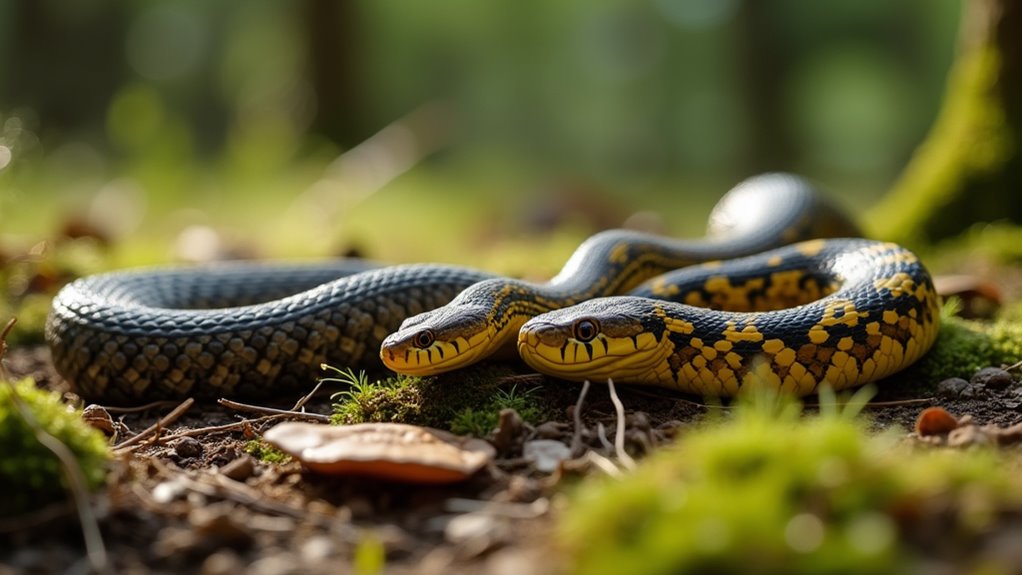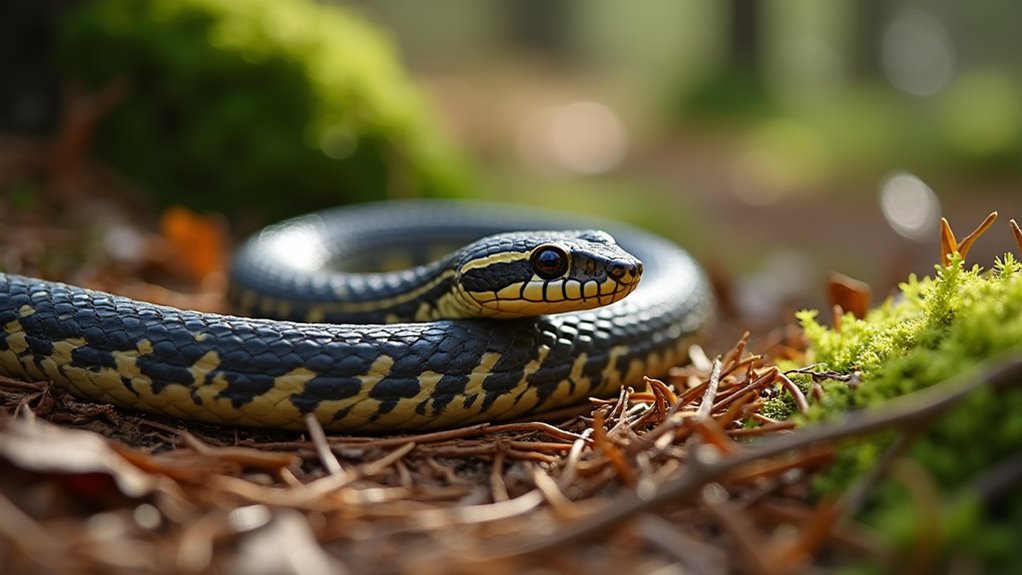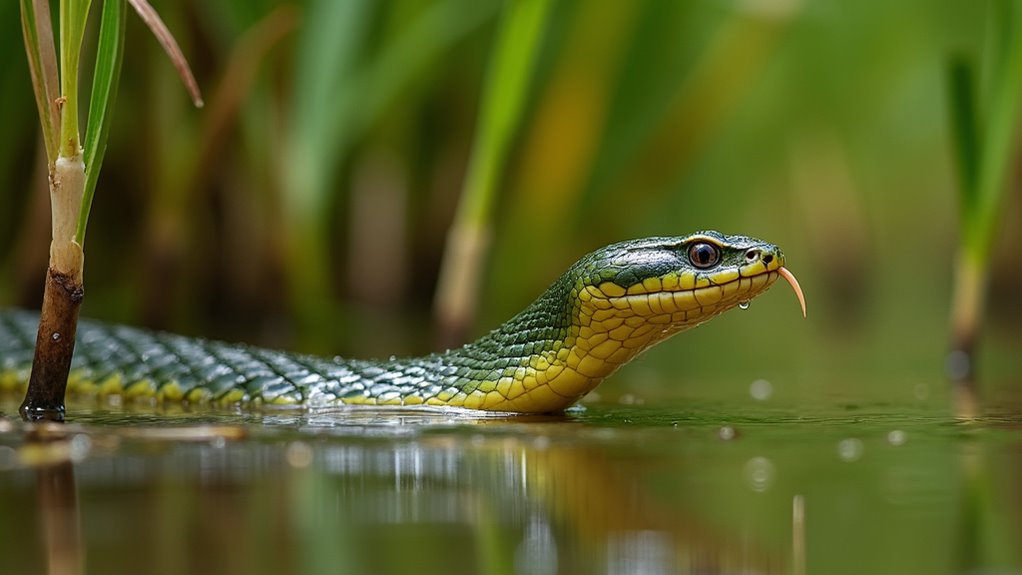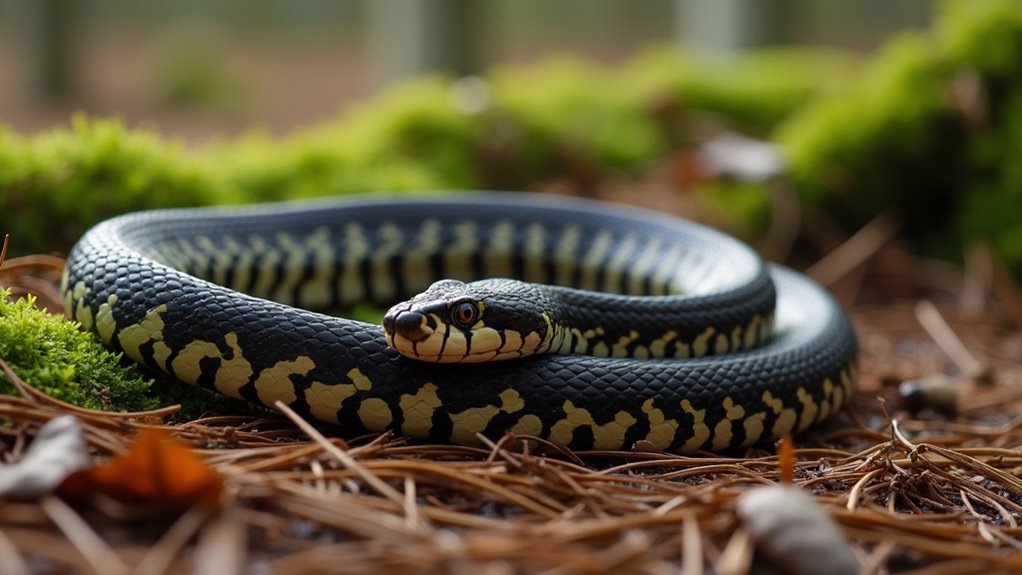Physical Address
304 North Cardinal St.
Dorchester Center, MA 02124
Physical Address
304 North Cardinal St.
Dorchester Center, MA 02124

Just when you thought German forests were safe, these 5 slithering species might change your mind during your travels.
Germany hosts two venomous species you should recognize: the European Adder with its zigzag pattern (common in northern flatlands and forests) and the European Asp Viper (found in southern rocky areas). Non-venomous varieties include the water-loving Grass Snake and the endangered Aesculapian Snake, Germany’s longest serpent. While snake encounters are rare, wearing proper footwear and staying on designated trails will keep you safe during your German adventures. Let’s explore these fascinating reptiles further.

When hiking through Germany’s diverse landscapes, you might encounter the European adder, the country’s most widespread venomous snake. You’ll find these shy creatures in the flatlands of Northern Germany, Black Forest, Swabian Alps, and Bavarian Forest, typically inhabiting heaths, forest edges, and coniferous forests.
Growing up to 28 inches long with a flat snout, adders prefer to avoid humans rather than confront them. Their venom is potent but usually only delivered when the snake is touched or stepped on. This non-aggressive nature means bites typically occur when the snake is provoked or stepped on.
If bitten, you’ll experience swelling, breathing difficulties, and potentially heart problems—seek medical attention immediately.
During winter, they hibernate in groups within compost heaps or rodent burrows, emerging in warmer months to hunt small mammals, birds, and insects.
While the European adder dominates most of Germany, you’ll find the European asp viper exclusively in the southern regions, particularly throughout the Southern Black Forest. This triangular-headed snake prefers rocky, sun-exposed areas at elevations between 800-1600 meters. In its natural habitat, the viper seeks out warm, sunny environments with structured vegetation and dry soils.
Though not typically aggressive, it will defend itself when threatened by coiling up, raising its head, and hissing. Similar to visiting Split, Croatia, experiencing Germany’s natural landscapes can be done on a budget-friendly basis if you plan properly.
While non-aggressive by nature, this viper will coil defensively, elevate its head, and emit warning hisses when provoked.
If you’re hiking in southern Germany, wear sturdy boots and watch your step in rocky terrain.

Moving from venomous species to one of Germany’s most common non-venomous snakes, the grass snake represents a completely different encounter in German wilderness. You’ll recognize it by its dark grey-green body with black bars along the flanks and distinctive yellow/black collar.
You’re most likely to spot these water-loving reptiles west of the Rhine River, particularly near ponds, rivers, and marshes. They’re completely harmless to humans, relying on fascinating defensive displays rather than venom – they’ll play dead or release a foul-smelling secretion when threatened. When cornered, grass snakes can also mimic cobras by raising their front body and flattening their head/neck, an interesting behavior that may have fossil origins.
If you’re exploring parks, gardens, or hiking near water bodies, watch for them basking on rocks or swimming. Unlike the bustling Croatian cities you might visit on a European tour, German natural areas offer peaceful reptile watching opportunities. They’re beneficial garden residents that help control amphibian populations and are protected by law throughout Germany.
Among Germany’s snake species, the Aesculapian snake (Zamenis longissimus) functions as the country’s longest serpent, reaching impressive lengths that make it a remarkable sight for wildlife enthusiasts. You’ll find these non-venomous creatures in isolated populations across Germany, particularly around Hirschhorn, Wiesbaden, and near Passau. The species is currently classified as Critically Endangered in Germany due to habitat fragmentation and human disturbances.
Despite their impressive size, these snakes aren’t dangerous and typically avoid confrontation when encountered. Similar to Zagreb’s wildlife, these serpents are part of Europe’s fascinating natural heritage worth observing during your travels.

Although Germany hosts only two venomous snake species, knowing how to identify and avoid these reptiles remains essential for safe outdoor exploration.
Despite Germany’s limited venomous snake diversity, identification and avoidance skills remain crucial for safe wilderness adventures.
The European adder, with its distinctive zigzag pattern and vertical pupils, inhabits heathlands and forest edges, while the rarer asp viper prefers rocky, sunny slopes. The European adder has been officially named Reptile of the Year for 2024 by the German Association for Herpetology and Terrarium Science due to conservation concerns.
When hiking, wear ankle-covering boots and step onto (not over) logs and rocks. Never attempt to handle snakes—most bites occur during interference.
If exploring high-risk zones like Lüneburg Heath or forest clearings, stay on designated paths and hike in groups. Many Europeans appreciate iconic dishes during outdoor adventures, but safety should always come first when exploring snake habitats. Remember that all native snakes are legally protected.
If bitten, keep the limb immobile below heart level and seek medical attention immediately. Don’t cut, suck wounds, or apply ice/tourniquets.
With proper care, serious outcomes are extremely rare.
As you explore Germany’s outdoors, remember these five serpents you might encounter. While snake bites are rare—with fewer than 30 reported adder bites annually across the country—it’s still smart to watch your step on trails. Wear proper hiking boots, stick to marked paths, and remember that German snakes typically avoid human contact. With this knowledge, you’ll enjoy Germany’s beautiful landscapes with confidence and respect for its slithering residents.